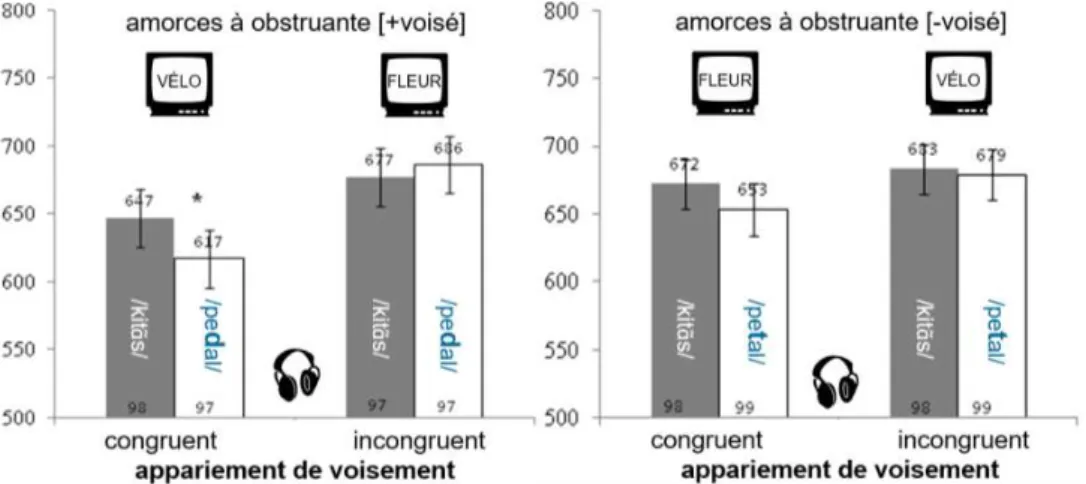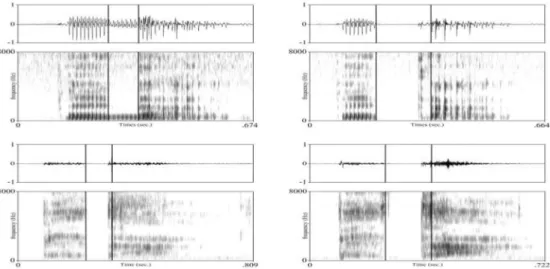HAL Id: hal-01980724
https://hal.archives-ouvertes.fr/hal-01980724
Submitted on 14 Jan 2019HAL is a multi-disciplinary open access archive for the deposit and dissemination of sci-entific research documents, whether they are pub-lished or not. The documents may come from teaching and research institutions in France or abroad, or from public or private research centers.
L’archive ouverte pluridisciplinaire HAL, est destinée au dépôt et à la diffusion de documents scientifiques de niveau recherche, publiés ou non, émanant des établissements d’enseignement et de recherche français ou étrangers, des laboratoires publics ou privés.
Ambiguïté temporaire des obstruantes voisées en parole
chuchotée
Yohann Meynadier, Dufour Sophie
To cite this version:
Yohann Meynadier, Dufour Sophie. Ambiguïté temporaire des obstruantes voisées en parole chuchotée. XXXIIè Journées d’Études sur la Parole, Jun 2018, Aix-en-Provence, France. pp.125-133. �hal-01980724�
Meynadier & Dufour (2016) ont
Meynadier & Dufour (2016) have studied how French listeners resolve voicing ambiguities in whispered speech. Visual targets were presented at the offset of auditory semantically-associated primes. A similar priming effect to that observed with modal primes was found only with whispered primes included a voiceless consonant (/petal/ t primed FLEUR ). No priming effect
was found with whispered primes included a voiced consonant (/pedal/ d ), either on the target
V LO /pedal/ or on the target FLEUR related to /petal/. Here, visual targets were
presented 50 ms after the offset of primes. While priming effects were no longer observed with whispered voiceless primes (/petal/ FLEUR), a priming effect emerged with whispered voiced primes
(/pedal/ V LO). Together, our results suggest that residual correlates of voicing present in whispered
speech are exploited by listeners to recover the intended words. Nonetheless, they also showed that the reconstruction of the voiced feature is not immediate during whispered word recognition and requires a certain amount of time to be done.
es : /p vs en opposition apparaissaient en position intervocalique de 2 tale dale, dessert sert, amphi envie). Ces 40 mots ont -test d libre
dale V LO, dessert CHOCOLAT, sert SABLE, amphi COURS,
envie D SIR. Les c
Pour
(par ex., quittance FLEUR/V LO, jumelle CHOCOLAT/SABLE COURS/D SIR),
constituant ainsi les conditions de s amorce est issue
et cible.
dale , dessert SABLE, sert CHOCOLAT, amphi D SIR, envie COURS.
30 couples amorce PION) ont
test. La (la cible)
e mot amorce entendu) de mot amorce
pseudo-ROUZE) et 40
visage PLAME). Ces pseudo- s
ou une permutation de lettres e en paire
chacune 8 136).
est reconduite ici.1 Comme elle, les nouveaux tests portent sur les 8 conditions dans la Table 1 : (i) deux
en paire minimale
voisement dale V LO tale FLEUR) ; (ii) deux en paire minimale est sans lien
avec la cible
minimale de voisement (appariement de voisement incongruent dale FLEUR tale V ) ; (iii)
quatre amorces s pour chaque condition (i) et (ii) n (quittance V LO, quittance FLEUR).
e . La taille de ce -stimuli est la plus
avec sa cible, cf. Dufour 2008 pour une revue).
Les participants mais co de , . La passation des tests a suivi exactement s que celle de l de 2016,
le .
2008). Les analyses (RT en ms) correctes. Par ailleurs, les RT 0 ms exclus. Afin
RT (Baayen & Milin 2010), puis pour chaque participant les RT
-rap pour F et p lmertest du logiciel R (Kuznetsova et al. 2016).
Voisement ([+ ], [ ]), Appariement de voisement (congruent, incongruent) et le (en paire minimale (Table
1) ,
T .
, ,
de la fonction glht du package multcomp (Bretz et al. 2011) avec une correction de Bonferroni. Les RT
1.
Figure 1 : RT moyen (ms) et erreur-typ s (barres grises) vs en paire minimale et [ (barres blanches) selon les conditions
Les pourcentages s correctes . indique un effet .
Le mod r v le un effet simple du T (paire minimale [F=5.22, p<.05] avec des RT plus rapides sur les mots cibles pr c d amorce en paire minimale une amorce contr le. Les effets simples de Voisement ([+ ], [ ]) et d Appariement de voisement (congruent, incongruent) gnent . T * Appariement de voisement est significative [F=6.64, p<.05]. est dans le cas dans le cas . La double interaction Voisement*T * Appariement de voisement est pas significative [F=1.86, p=.18].
[ ]) lent une interaction significative *Appariement de voisement seulement pour les [+ ] dale [F=6.56, p<.05] et non pour [
tale [F=0.44, p>.20]. Pour les , l
deux avec une correction de Bonferroni montrent un effet f seulement pour les couples amorce cible s en voisement (congruent, dale [z=3.03, p<.05]. Dans ce cas, le RT (617 ms) est en moyenne 30 ms plus rapide
quittance . En revanche, couples amorce cible incongruent dale quittance
[z=-1.01, p>.20]. Pour les est observ , tant pour les couples amorce cible congruent tale
quittance [z=2.06, p>.20] que pour incongruent, tale quittance ) [z=0.92, p>.20].
Pour les pour un logit a ontrairement
un
obstruante [+ ]. Cependant
2016) pour les mots amorce [ est plus avec de traitement plus long.
(2x20) o
et
de (Figure 2). Ce sont mes stimuli que ceux Meynadier & Dufour (2016)
manuelle. Cette liste de 40 mots comprend 4 paires avec /p b/, 5 avec /t d/, 2 avec /k g/, 5 avec /f v/, 3 avec /s z/ et 1 avec /
Figure 2 : Onde acoustique et spectrogramme des amorces /pedal/ ( ) et /petal/ ( ) en parole modale (en haut) (en bas). Les obstruantes /d/ et /t/
res.
Analyse statisti
acoustiques du voisement
Les 20 amorces ruante [+ ]
paire minimale par un test de Student sur les cinq -avant : d
. Ces analyses portaient sur les productions et modale.
Parole modale L , 49
dB) que le sourdes (151 ms, 57 dB) [respectivement, t(38)=7.63, p<.0001 ; t(38)=2.77, p<.01]. Les (154 ms) (118 ms) [t(38)=3.18, p<.01]. Aucune diff rence significative ne concerne le Centre
obstruantes : 3714 Hz ; [ : 3960 Hz) [t(38)=0.59, p>.20], ni la Dispersion : 1871 Hz ; [ : 1862 Hz) [t(38)= 0.07, p>.20].
P L urtes (98 ms) que les sourdes (158 ms) [t(38)=7.06, p<.0001
t(38)=4.20, p<.001]. pour RMS : 52 dB ; [ : 55 dB) [t(38)=1.22, p>.20], le
: 3370 Hz ; [ : 3896 Hz) [t(38)=1.16, p>.20] ou la D spectre de bruit : 1416 Hz ; [ : 1672 Hz) [t(38)=1.34, p=.19]. En accord avec pour
en parole
dale
[
tale
(comparaisons post-hoc par paire avec une correction de Bonferroni ; amorces modales : z=3.49, p<.01 ; : z=3.02, p<.05) [ [ obtenus en parole modale aussi bien [ [z=2.03, p>.20] que [+ [z=1.98, p>.05]. d au fait que
(Marslen-Wilson et al. 1996, Andruski et al. 1994). Ainsi, en
augme , nous preni
pour les amorces 50 ms entr
ermet s
s s lexicales effet
probablement sur un processus d voisement et toujours
dans le signal
acoustiques les auditeurs de obstruante et/ou de la voyelle qui la
ANDRUSKI J.E., BLUMSTEIN S.E., BURTON M. (1994). The effects of subphonetic differences on lexical
access. Cognition 52, 163-187.
BAAYEN R.H. (2008). Analyzing linguistic data: A practical introduction to statistics using R.
Cambridge: Cambridge University Press.
BAAYEN R.H., MILIN P. (2010). Analyzing reaction times. International Journal of Psychological
BRETZ F., HOTHORN T., WESTFALL P.H. (2011). Multiple comparisons using R. Boca Raton: CRC Press.
DANNENBRING G.L. (1980). Perceptual discrimination of whispered phoneme pairs. Perceptual and
Motor Skills 51(3), 979-985.
DUFOUR S. (2008). Phonological priming in auditory word recognition: When both controlled and
automatic processes are responsible for the effects. Canadian Journal of Experimental Psychology 62, 33-41.
FUX T. (2012). Ve .
, Grenoble.
GARNIER M., BOUHAKE S., JEANNIN C. (2014). Efforts and coordination in the production of bilabial
consonants. Proceedings of the 10th Int. Seminar on Speech Production, 138-141. Cologne.
GILICHINSKAYA Y.D. (2012). Perception of final c v in phonated and whispered
speech. UMI Dissertation Publishing, ProQuest LLC, Ann Arbor, USA.
HALLE P., ANDROJNA K., SEGUI J. e : elle vaut pour les
non-mots autant que les mots. Actes des XXIX JEP, 441-448.
HALLE P., SEGUI J., FRAUENFELDER U., MEUNIER C. (1998). The processing of illegal consonant clusters:
a case of perceptual assimilation? Journal of Experimental Psychology: Human Perception and Performance 24, 592-608.
ITO T., TAKEDA K., ITAKURA F. (2005). Analysis and recognition of whispered speech. Speech
Communication 45(2), 139-152.
J S.T., Z. (2008). Acoustic analysis of consonants in whispered speech. Journal of Voice
22, 263-274.
KOHLBERGER M., STRYCHARCZUK P. (2015). Voicing assimilation in whispered speech. Proceedings of
the 18th International Conference on Phonetic Sciences. Glasgow.
KUZNETSOVA A., BRUUN BROCKHOFF P., HAUBO BOJESEN CHRISTENSEN R. (2016). Tests in linear mixed
effect models. 20/11/2017, https://cran.r-project.org/package=lmerTest.
M A., PEEBLES K. (1965). An optical device for recording glottal adduction-abduction during
normal speech. ZPSK 18, 545-550.
MARSLEN-WILSON W.D., MOSS H.E., VAN HALEN S. (1996). Perceptual distance and competition in lexical
access. Journal of Experimental Psychology: Human Perception and Performance, 22, 1376-1392.
MEYNADIER Y. (2015). Aerodynamic tool for phonology of voicing. Proceedings of the 18th
International Conference on Phonetic Sciences, paper#0497. Glasgow.
MEYNADIER Y., DUFOUR S XXXI -27. Paris.
MEYNADIER Y., GAYDINA Y. (2013). Aerodynamic and durational cues of phonological voicing in
whisper. Proceedings of the 14th Interspeech, 335-339. Lyon.
MILLS T.L.P. (2009). Speech motor control variables in the production of voicing contrasts and
emphatic accent. Ph Dissertation, University of Edinburg, Ednburgh.
MUNRO M.J. Phonetica 47(3-4), 173-181.
NETSELL R. (1969). Subglottal and intraoral air pressures during the intervocalic contrast of /t/ and /d/.
Phonetica 20(24), 68-73.
SLIS L.H. (1970). Articulatory measurements on voiced, voiceless and nasal consonants. Phonetica
21(4), 193-210.
TABOSSI P. (1996). Cross-modal semantic priming. Language and Cognitive Processes 11, 569-576. TARTTER V.C. The Journal of the Acoustical Society of America, 86,
1678-1683.
VAN DE VELDE D.J., VAN HEUVEN V. (2011). Compensatory strategies for voicing of initial and medial
plosives and fricatives in whispered speech in Dutch. Proceedings of the 17th ICPhS, 2058 2061. Hong-Kong.
VERCHERAND G. (2010).

